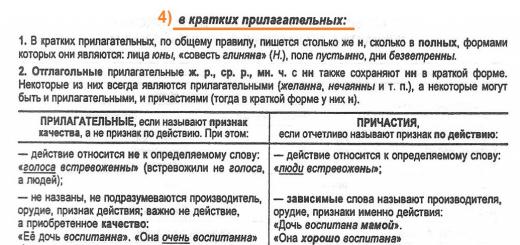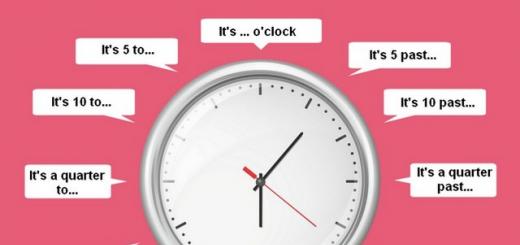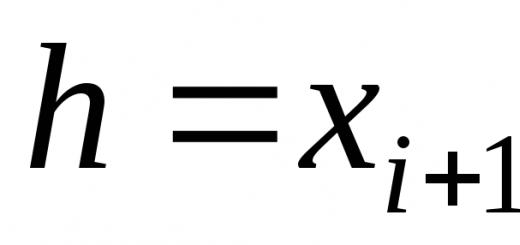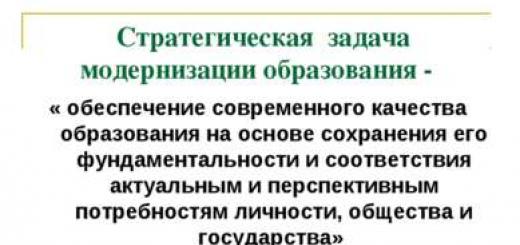Not a single day goes by without us looking at the clock, telling or asking the time. From this article you will learn how to say time in English, how AM and PM stand for it, and what “military time” is.
Basic English words on the topic “Time”
What are AM and PM?
In English, the day is clearly divided into two periods: AM and PM.
- AM – 00:00 - 12:00 or from midnight (midnight) to noon (midday);
- PM – 12:00 - 00:00 or from noon to midnight.
These abbreviations are not English, but Latin, they stand for ante meridiem(before noon) and post meridiem(afternoon). When naming time, these two abbreviations are often added to make it clear what time of day we are talking about.
A simple way to tell time in English
In Russian, we can call time simply by two numbers without any “twenty to twenty”, “half”, “quarter to” and so on. The same method exists in English.
- 03:15 – Three fifteen (three fifteen).
- 04:35 – Four thirty-five (four thirty-five).
If the exact hour without minutes is specified, then this hour is called + “o’clock”.
- 11:00 – Eleven o’clock (eleven o’clock).
- 10:00 – Ten o’clock (ten o’clock).
In speech, tense sentences are constructed with the formal subject it. According to the rules of grammar, a sentence must have a subject - it formally fulfills this role.
- It is five twenty-five AM. - It's five twenty-five in the morning.
- It's ten thirty PM. - It's ten thirty in the evening.
In our country you can often hear not “six in the evening”, but “eighteen hours”; in America, the 24-hour time format is practically not used in everyday life; it is used mainly by police officers, military personnel, technicians and people of other professions in which accuracy is important. This designation of time is called military time- "war time". By the way, how would you say 17:00 in English? Not seventeen o’clock or seventeen zero zero at all. It will be right seventeen hundred– literally, “seventeen hundred.”
Telling the time in English by the clock
Another, more common, way of saying time is by using expressions like “half past four” instead of “four thirty”, “a quarter to two” instead of “one forty five”, etc.
How this is done is shown in detail in the picture:

We call the exact time without tricks: It's... o'clock:
- It's ten o'clock. - It's ten o'clock now.
- It's four o'clock. - It's four o'clock now.
We call time with 30 minutes using half past(lit.: half after):
- It's half past four. - It's half past four now.
- It's half past one. - It's half past two now.
We call time with 15 minutes using a quarter past(a quarter after) or “a quarter to” (without a quarter):
- It’s a quarter past seven. - It's quarter past seven.
- It's a quarter to nine. - It's a quarter to nine now.
All other time options are indicated using to(without) or past(after).
- It's five past seven. – It’s five minutes past seven (lit.: five after seven).
- It's twenty-five to eleven. – It’s now twenty-five minutes to eleven (lit.: twenty-five to eleven).
Other useful words and expressions on the topic "Time"
One of the difficulties associated with the topic of time in English is the correct use of prepositions in different expressions. Mentions of time in conversations are far from limited to phrases like “It’s half past five.” For beginners, confusion often arises in the expressions “in an hour”, “at nine o’clock”, etc.
You can familiarize yourself with prepositions of time in this collection; below I also provide some template expressions that may be useful to you.
| I'll come back in ten minutes | I will be back in 10 minutes |
| He can fix it within 5 minutes | He can fix it within 5 minutes |
| We open at seven o'clock | We open at 7 o'clock |
| What's the time? | How much time? |
| It's nine o'clock | (now) 9 o'clock |
| Can you wait one more second? | Can you wait another second? |
| What time do you close? | What time do you close? |
| What are your working hours? | When do you work? (What are your working hours?) |
| by ten o'clock | by ten o'clock |
| He always arrives on time. | He always arrives on time |
| I'm busy at the moment | I'm busy at the moment |
| Meet me in about ten minutes | Meet me in about ten minutes |
| Give me a call at nine o'clock sharp | Call me at nine o'clock sharp |
| We don't have much time | We don't have much time |
| Don't talk during the film | Don't talk during the movie |
| I like to take a nap in the afternoon | I like to take a nap during the day |
| Don't walk alone at night | Don't walk alone at night |
Hello, dear readers of the blog site. It seems like a question, but how often does it arise? For example, it is always difficult for me to immediately remember when working with English-language services how much 10.00 PM is in terms of our time (does this mean morning or evening?). And in general, where did these AM and PM come from?, who needs them and why not use only the 24-hour format?
Well, the question here is probably from the same area as the use of right-hand traffic in some countries - it’s just the way it is and nothing can be done about it. We just need to deal with these a.m. once and for all. and p.m. (get into your head the relationship with the 24-hour ruler), or, at worst, write yourself a cheat sheet (if, like me, nothing sticks in my head for a particularly long time). Where should I write? Yes, right here, that is. on the pages of your blog. I'll do so...
Are we really that far from the 12 hour clock?
The time format using AM and PM is widespread not only in the bourgeoisie; sometimes its echoes can be observed in the RuNet space (mainly in localized bourgeois projects). For example, well-known to many bloggers, he suggests choosing the time for sending letters to subscribers based on the 12-hour format, rather than the 24-hour one:

It seems that the time zone indicates that here a.m. and p.m. do not understand, and the interface is translated into Russian. But no, habit is second nature. How should I understand 11:00 am - 1:00 pm? Is it from eleven in the morning to one in the afternoon or from eleven in the evening until one in the morning? You need to google, and so on every time, to know for sure...
Although, I probably shouldn’t have attacked the bourgeoisie with their AM and PM. If you think about it, then You and I also half live in a 12-hour world. For example, when they ask you the time, you don’t answer that it’s fifteen minutes to eighteen, but say that it’s fifteen minutes to six, and a person can determine whether it’s evening or morning. In this regard, we are the same.
At the same time, in Russian-language texts in most cases (and always) a 24-hour time scale is used. But our clocks are again in 12-hour format. It would probably be difficult to fit 24 hours in there and it would look overloaded.

But our digital watches, again, are 24-hour, but the Americans, judging by the films, are 12-hour with an indication of a.m. and p.m.

Oh, how everything in life is mixed up, if you think about it.
Decoding and nuances of using A.M. and P.M.
But this is all verbiage, and what do AM and PM mean?(how these abbreviations stand for). It turns out that these abbreviations are Latin and literally mean the following:
- AM - before noon
- PM - after noon (by the way, this is easier to remember, because the first letters in the Russian and Latin names are the same)
This can be illustrated quite well with these two pointer chronometers:

Then PM is evening, and AM is morning. Everything seems simple, but there is a small problem. Everything is fine until it comes to it until noon or midnight, i.e. rendezvous places for cycles a.m. and p.m.
In general, it turns out that in different countries that accept the 12-hour cycle, these moments may be celebrated differently ( and 12 p.m., and 12 a.m.). Thus, there can be discrepancies (such as “the glass is half full or it is half empty”). For me, it would be more logical to use not 12 p.m., but 0 p.m., which would be much more logical, but the bourgeoisie know better. The end result is this, in my opinion, nonsense:

After 12 a.m. it's 01a.m. etc. And after 12 p.m. it's 01p.m. I personally find it difficult to get used to (how can one come after 12?). Americans generally mark midnight in documents as 11:59 p.m., and noon as 12:01 a.m., so that legal incidents and discrepancies do not arise. They're kind of strange...
Conversion table from AM and PM to 24 hour format
Well, the complete table of correspondence between the 12 and 24 hour time format will then look like this:
Good luck to you! See you soon on the pages of the blog site
You might be interested
Is hedonism normal or immoral? What is discipline - why is it needed, its types (military, labor), consequences of violation and ways to improve What are antonyms and examples of enriching the Russian language with them What is modernization What is personality - what qualities is it characterized by, examples of historical and modern strong personalities Perception in psychology - its types, properties, errors (illusions) and features of human perception by humans Litotes is understatement and softening to create an image A sybarite is a person seeking pleasure or a playmaker What is deja vu Google Calendar - what it can do and how to use it to its full potential What is truth - we are looking for a true interpretation, defining its criteria and studying the types (absolute and relative truths)
When we talk about time in English, we use abbreviations such as AM and PM. What do they mean and what is the difference between them? In this article we will look at their use.
A.M.
Pronunciation and translation: 
A.m. / [ee em] - before noon
Meaning of the word:
Time after midnight and before noon
Use:
Reduction a.m.(from the Latin ante meridiem, "before noon") - this interval begins at 12 o'clock at night (midnight) and ends at 12 o'clock in the afternoon (noon). That is, it lasts With 00:00 to 12:00. For example: I woke up at 8 am.
By the way, midnight is usually designated as 12 a.m. , this is like the beginning of a period of time a.m.
Example:
It's two a.m.
Two o'clock in the morning. (2:00)
It's ten a.m.
Ten in the morning. (10:00)
P.M.
Pronunciation and translation: 
P.m. / [pi em] - afternoon
Meaning of the word:
Time from noon to midnight
Use:
Reduction p.m.(from the Latin post meridiem "after noon") - this interval begins at 12 noon (noon) and ends at 12 midnight (midnight). That is, it lasts from 12:00 to 00:00. For example: We finished at 10 pm.
By the way, noon is the beginning of the p.m. interval. It is customary to denote 12 p.m.
Example:
It's ten p.m.
Ten pm. (22:00)
It's five p.m.
Five in the evening. (17:00)
What is the difference?
We use a.m., when we talk about the interval from 12 o'clock at night (midnight) to 12 o'clock in the afternoon (noon). That is With 00:00 to 12:00. For example: He arrived at 6 am.
We use p.m., when we talk about the interval from 12 o'clock in the afternoon (noon) to 12 o'clock at night (midnight). That is from 12:00 to 00:00. For example: We met at 9 pm.
Consolidation exercise
Insert the correct abbreviation into the following sentences. Leave your answers in the comments below the article.
1. Meeting at 10 am.
2. She fell asleep at 12 am.
3. Lunch at 2 pm.
4. It's 7 am.
5. They will arrive at 3 days.
6. We fly out at 3 am.
In English, numbers indicating the time are often followed by the mysterious letters am or pm. What is the meaning of these abbreviations and how are they deciphered?
Incomprehensible letter symbols with dots “a.m” and “p.m” are used when indicating European time, which is calculated in a 12-hour format, and not in the usual 24-hour format. For Americans, the day is divided into 2 halves - from 12 at night to 12 noon and is marked with the letters a.m., and the rest of the time is marked with p.m.
In other words, the abbreviation "a.m" is the time before noon: from 12 o'clock at night to 12 o'clock the next day. It stands for Ante meridiem, a Latin phrase that translates as “before noon.” The time from noon to 12 o'clock at night is designated by the abbreviation "p.m" - this is the time after 12 o'clock in the afternoon. It stands for Post meridiem, which means “after noon” in Latin.
Thus, in English, when indicating time, it is not necessary to say or write the word “o" clock after each digit. You can simply say “it is 5.” But to indicate that it is five o’clock in the evening, you need to clarify - it is 5 p.m.
National features of time notation
In America, the 24-hour time format is practically not used in everyday life; it is used mostly by technicians, police officers, military personnel, and people in professions that require precision. This designation of time is called “military time”.
In documents, Americans mark midnight as 11:59 p.m., and noon as 12:01 a.m., in order to avoid legal incidents and other discrepancies.
Europeans are already accustomed to this type of time calculation, but we are closer to our native 24-hour format, it eliminates confusion with “noons.” In the world, almost all mechanical watches (with hands) are marked according to the English system, that is, the 24-hour format. Electronic ones can show time using two systems. So, in America, for example, clocks showing am and pm are quite common.

Learning by example
Meaning of abbreviations a.m./p.m. best learned through examples. So:
- 1 a.m. means 1 am;
- 2 a.m., 3 a.m. and so on, until 8 a.m. mean 2 am, 3 am and 8 am;
- time from 9 a.m. and until 11 a.m. considered "late morning" from 9 to 11 am;
- 1 p.m. - it's 1 o'clock in the afternoon, 2 p.m. - 2 pm and so on, until 6 p.m. (six pm) and until 11 p.m. (11 p.m);
It can be expressed differently as follows:
Examples with translation
- 03:17 a.m. m - Three seventeen in the morning (three seventeen in the morning).
- 04:40 p.m. — Four forty p.m. in the afternoon (four forty days).
- If the exact time is specified, a specific hour without minutes, this hour is called + “o" clock.
- 10:00 - ten o'clock (ten hours).
- 09:00 — nine o’clock (nine hours).
- It is five fifteen AM. — It’s five fifteen in the morning.
- It's seven thirty PM. — It’s seven thirty in the evening.
- Examples of tenses in sentences
- This letter we must send out at 3 a.m. — We must send this letter at 3 am.
- Roger Brown arrived in New-Jersey at 7:44 A.M. — Roger Brown arrived in New Jersey at 7:44 am.
- Opening Hours: Monday - Saturday 8 am - 8 pm, Sundays 10 am - 7 pm. — Opening hours: Monday - Saturday from 8 am to 8 pm, on Sundays from 10 am to 7 pm.
- Tomorrow I’ll wake up at 7 am, no the latter. — Tomorrow I will wake up at 7 o’clock in the morning, not earlier.
- Their flight to Boston would leave Glasgow at 7:10 a.m. Friday. — Their flight to Boston will leave Glasgow at 7:10 am on Friday.
- Today I’m going to work up to 9 p.m. — Today I’m going to work until 9 pm.
- My wife usually wakes up at 5 a.m. — My wife usually wakes up at 5 am.
- We estimate him here by 11:25 p.m. — We estimate that he will be here before 11.25 pm.
- Open today: 7:00 am – 10:00 pm. — Opening hours today: from 7:00 am to 10:00 pm.
Conversion table from AM and PM to 24 hour format
| 24 hour format | 12 hour format | In colloquial speech |
| 00:00 (midnight) | 12:00 a.m. (midnight) | Twelve at night |
| 01:00 | 1:00 a.m. | One o'clock in the morning |
| 02:00 | 2:00 a.m. | Two nights |
| 03:00 | 3:00 a.m. | Three nights |
| 04:00 | 4:00 a.m. | Four nights |
| 05:00 | 5:00 a.m. | Five in the morning |
| 06:00 | 6:00 a.m. | Six in the morning |
| 07:00 | 7:00 a.m. | Seven in the morning |
| 08:00 | 8:00 a.m. | Eight in the morning |
| 09:00 | 9:00 a.m. | Nine in the morning |
| 10:00 | 10:00 a.m. | Ten in the morning |
| 11:00 | 11:00 a.m. | Eleven in the morning |
| 12:00 (noon) | 12:00 p.m. (noon) | Twelve days |
| 13:00 | 1:00 p.m. | One o'clock |
| 14:00 | 2:00 p.m. | Two days |
| 15:00 | 3:00 p.m. | Three days |
| 16:00 | 4:00 p.m. | Four days |
| 17:00 | 5:00 p.m. | Five days |
| 18:00 | 6:00 p.m. | Six p.m. |
| 19:00 | 7:00 p.m. | Seven pm |
| 20:00 | 8:00 p.m. | Eight pm |
| 21:00 | 9:00 p.m. m | Nine pm |
| 22:00 | 10:00 p.m. | Ten pm |
| 23:00 | 11:00 p.m. | Eleven pm |










